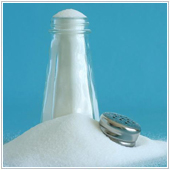 Salt is everywhere. Chicken noodle soup, pizza and even “healthy” frozen dinners are some of the biggest culprits. It’s a huge part of the American diet, but it’s also a source of controversy.
Salt is everywhere. Chicken noodle soup, pizza and even “healthy” frozen dinners are some of the biggest culprits. It’s a huge part of the American diet, but it’s also a source of controversy.
Do you know how much sodium you consume each day? The average adult takes in 50 to 100 percent more than the recommended maximum of daily sodium intake. Chances are, you’re eating more salt than recommended without even knowing it. And while many of us have been told to reduce salt intake for health reasons, the evidence (or lack thereof) to support that advice is up for discussion.
The war on salt
The CDC and the American Heart Association currently recommend that the appropriate salt intake for adults under 50 is about 2,300 mgs. For those over 50, the recommendation drops to 1,500 mgs. But new research appearing in the American Journal of Hypertension shows that national diet guidelines regarding salt intake are unreasonable and possibly hazardous to your health. In fact, some professionals say that the amount of sodium 95% of Americans consume on a daily basis, which is 2,645 to 4,945 mgs, is actually associated with better mortality rates than low-salt diets.
According to Brian Strom, MD, chair of the Institute of Medicine’s report committee, there is no evidence to support the idea that people who consume less than 2,300 milligrams of sodium each day have fewer strokes or heart attacks than those who consume higher amounts.
The danger of low-salt diets
Because salt has been vilified for many years, it’s easy to forget that sodium is an essential nutrient providing many functions in the body. It helps to control heart rate and aids in the transmission of brain signals. Studies have found that while lowering sodium consumption can have a positive effect on blood pressure, it can also increase cholesterol and insulin resistance. So the blood pressure benefits may not be worth the associated negatives.
A startling 2011 study tracked 28,880 people with heart disease or diabetes and found that those who consumed less than 2,000 milligrams of sodium a day were 37 percent more likely to die of heart disease than those who consumed 4,000 to 6,000 milligrams. As sodium intake drops, blood levels of cholesterol and fat can increase, escalating cardiovascular issues.
So what’s the answer?
According to WebMD, a recent study shows that both too little and too much salt are harmful, so we need to find a happy medium. While new research suggests that Americans consume a healthy amount of salt, the U.S. Centers for Disease Control and Prevention continue to stand by their recommendations. Most people can still afford to cut back, but avoiding a low-salt diet can ensure you’re getting to reap the health benefits that salt has to offer.
It’s always helpful to consult a health professional when considering a new diet. A low-salt diet is no exception. We recommend taking a closer look at your daily sodium intake to make sure it isn’t too low or too high. And don’t forget, you have an incredible health resource at your fingertips when you visit [company_short]. Please feel free to stop by or give us a call at [phone_main] with any concerns.